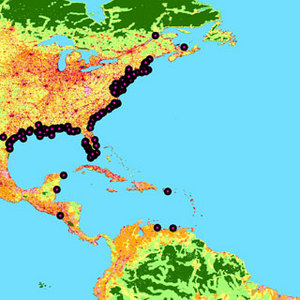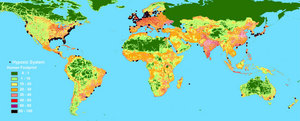
|
| ©Science/AAAS |
| Dead Zone: Waters with little or no oxygen continue to form in coastal areas worldwide thanks to fertilizer washing off agricultural fields and fossil fuel burning. |
More bad news for the world's oceans: Dead zones - areas of bottom waters too oxygen depleted to support most ocean life - are spreading, dotting nearly the entire east and south coasts of the U.S. as well as several west coast river outlets.
According to a new study in Science, the rest of the world fares no better - there are now 405 identified dead zones worldwide, up from 49 in the 1960s - and the world's largest dead zone remains the Baltic Sea, whose bottom waters now lack oxygen year-round.
This is no small economic matter. A single low-oxygen event (known scientifically as hypoxia) off the coasts of New York State and New Jersey in 1976 covering a mere 385 square miles (1,000 square kilometers) of seabed ended up costing commercial and recreational fisheries in the region more than $500 million. As it stands, roughly 83,000 tons (75,000 metric tons) of fish and other ocean life are lost to the Chesapeake Bay dead zone each year - enough to feed half the commercial crab catch for a year.
"More than 212,000 metric tons [235,000 tons] of food is lost to hypoxia in the Gulf of Mexico," says marine biologist Robert Diaz of The College of William & Mary in Williamsburg, Va., who surveyed the dead zones along with marine ecologist Rutger Rosenberg of the University of Gothenburg in Sweden. "That's enough to feed 75 percent of the average brown shrimp harvest from the Louisiana gulf. If there was no hypoxia and there was that much more food, don't you think the shrimp and crabs would be happier? They would certainly be fatter."
Only a few dead zones have ever recovered, such as the Black Sea, which rebounded quickly in the 1990s with the collapse of the Soviet Union and a massive reduction in fertilizer runoff from fields in Russia and Ukraine. Fertilizer contains large amounts of nitrogen, and it runs off of agricultural fields in water and into rivers, and eventually into oceans.
This fertilizer runoff, instead of contributing to more corn or wheat, feeds massive algae blooms in the coastal oceans. This algae, in turn, dies and sinks to the bottom where it is consumed by microbes, which consume oxygen in the process. More algae means more oxygen-burning, and thereby less oxygen in the water, resulting in a massive flight by those fish, crustaceans and other ocean-dwellers able to relocate as well as the mass death of immobile creatures, such as clams or other bottom-dwellers. And that's when the microbes that thrive in oxygen-free environments take over, forming vast bacterial mats that produce hydrogen sulfide, a toxic gas.
"The primary culprit in marine environments is nitrogen and, nowadays, the biggest contributor of nitrogen to marine systems is agriculture. It's the same scenario all over the world," Diaz says. "Farmers are not doing it on purpose. They'd prefer to have it stick on the land."
In addition to fertilizers, the other primary culprit is the consumption of fossil fuels. Burning gasoline and diesel results in smog-forming nitrogen oxides, which subsequently clear when rain washes the nitrogen out of the sky and, ultimately, into the ocean.
Technological improvements, such as electric or hydrogen cars, could solve that problem but the agricultural question is trickier. "Nitrogen is very slippery; it's very difficult to keep it on land," Diaz notes. "We need to find a technology to keep nitrogen from leaving the soil."
Or farmers can reduce the overall amount of nitrogen required by employing new biotechnologies, such as the nitrogen use efficiency (NUE) improvements offered by Arcadia Biosciences. By engineering crops to overexpress a gene that allows roots to absorb more nitrogen, Arcadia scientists have shown that "it's possible for NUE crops to produce the same yield with half as much fertilizer," president and CEO, Eric Rey, says. "In canola, we saw a two-thirds reduction."
Seeds bearing the technology have already been licensed to agricultural giants Monsanto Company and Dupont's Pioneer Hi-Bred International in the case of canola and corn, respectively - and even grass seed from Scotts Miracle-Gro Company may one day employ it. Although field trials over the last four years have proved the genetic changes effectiveness, further testing and government approval means that such crops will not be grown before 2012.
"It's a big economic benefit for farmers if they use only half as much nitrogen as well a big beneficial impact on nitrogen runoff into waterways," says Rey, who hopes that this product will be adopted as quickly as herbicide-resistant crops, which only took five years from introduction in 1998 to become nearly 70 percent of the corn grown in the U.S., and is now nearly 90 percent. "A reasonable expectation is that there would be a dramatic reduction, maybe by 2018."
But that still might not solve the dead zone problem. So much nitrogen is now reaching these coastal waters that much of it ends up buried in sediment, Diaz says, even when new nitrogen sources are removed those sediments release that nitrogen over time, perpetuating the cycle.
That inability to recover is driven not only by the nitrogen buried in the sediment but also by water layers that don't mix with one another, despite the massive flow of rivers like the Mississippi. Instead, warmer, fresher water on the surface sits on top of cooler, denser, saltier water and it takes the energy of multiple powerful hurricanes to blend the two.
For example, as Hurricane Katrina bore down on the Louisiana coast with its powerful winds blowing faster than 130 miles (210 kilometers) per hour, the monstrous tropical storm delivered a benefit: it mixed the warm, oxygen-rich surface waters with the colder, almost oxygen-free waters beneath, dispelling the largest dead zone in the U.S. for a time. Hurricane Rita followed and finished the work, ending early the seasonal dead zone that forms each year at the mouth of the Mississippi.
That dead zone - which last year stretched over roughly 8,500 square miles (22,000 square kilometers), an area the size of New Jersey, and is predicted to grow even more extensive in 2008, thanks to the early summer floods - forms because of the rich load of nitrogen and phosphorus the Mississippi carries down from the farm fields of the U.S. Midwest.
Hoping for hurricanes is neither popular nor sensible, so scientists in the Baltic Sea nations, desperate for solutions, are considering so-called geoengineering options: large-scale human interventions into natural systems. In this case, air would be bubbled into some of the smaller bays to assess what happens. "If you look at agricultural ponds, you can aerate them to prevent low oxygen," Diaz says. "But that's a pond. We're talking about open systems with tides. The water doesn't just stay there."
Ultimately, it may take revolutions in agriculture and transportation, along with the energy of hurricanes to bring life back to dead zones. "If you can't mix a dead zone with the energy of a hurricane," Diaz adds, "I don't see how geoengineering is going to do it."

|
| ©Unknown |



Reader Comments
to our Newsletter